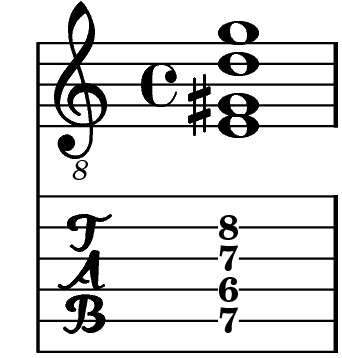Essential Guitar Chords: the Jimi Hendrix Chord
Few sound have been more iconic than the sound of this chord. It is definitely not a “nice” chord: nasty, dissonant, yet appealing. The Hendrix chord, one of the pillars of modern guitar sound. Let’s see what it is and how to play it.
The Basics
Let’s start from the practical things: here is how to play an E7/#9, the “Hendrix Chord”:

Take your guitar and try to play it so you can hear what we are talking about.
The Theory Behind It
Now we are ready to see some theory on this chord. Let’s build an E7/#9. First of all, we need an E major triad (E, G#, B). To these notes we need to add the 7th of the chord (the note 10 fret higher than the root, in our case D) and the #9 of the chord (The note 15 frets higher than the root, in our case G). So E7/#9 is made by E, G#, B, D, G.
But, you will say, wait a second. E7/#9 has 5 notes in it, how comes the chord shape we learned just a moment ago has just 4 notes in it? Good observation! It happens often with chords that are more complicated than a triad that we omit notes when we are playing them on the guitar. This is because sometimes the shape resulting by including all notes will be too difficult to play, sometimes it would be downright impossible. In most cases, the safest note to leave out is the 5th of the chord (in our case the B note); this is also the note we omitted in the chord shape we have seen above.
Where to Use It: Some Examples
In general, any dominant chord (chords like E7) can be substituted with a 7/#9. This means that any time you should play a 7th chord, you can try to play in a 7/#9 chord instead. So, as you see you can apply it in a variety of situations.
As an example, we can take the standard 12-bar Blues progression in A: A, A, A, A7, D, D7, A, A7, E7, D7, A, E7. A typical thing to do is to play an E7/#9 instead than the E7. Another thing to do is to play a 7/#9 chord anytime there is a 7th chord, so that the progression becomes: A: A, A, A, A7/#9, D, D7/#9, A, A7/#9, E7/#9, D7/#9, A, E7/#9.
Another way of using the Hendrix Chord is to play a chord progression like this:

You can use these snippets in your songs to make them more interesting. As usual, the key here is to experiment with it and see what you can make with it. If it sounds good to you, then it is good!
As you can see, the Hendrix Chord is very easy to play and it sounds great! What most people don't know, though, is that the Hendrix chord is but one of a family of chords called "altered chords". Click on the button below to see how altered chords on guitar work and how they can make your songs sound better and different than everybody else:
